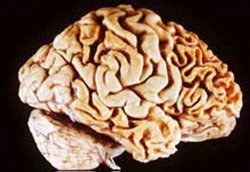Large studies have shown that fewer than 10 percent of patients with dementia have a form of the disease that is partially reversible, and only 1.5 to 3.0 percent of patients have fully reversible dementia. Because of these findings, it has been suggested that neuroimaging should not be a part of the routine work-up for dementia in patients presenting with cognitive decline. Massoud and colleagues conducted a study to determine the neuropathologic diagnoses of dementia patients, to compare the neuropathologic findings with results from neuroimaging studies and to assess the results of a dementia work-up compared with the pathologic diagnosis.
Persons were enrolled from a tertiary care facility for patients with cognitive problems if they had a diagnosis of dementia--Alzheimer's disease (AD), vascular dementia or mixed dementia (components of AD and vascular dementia present in the same patient). Neurologic, functional and psychiatric examinations were reviewed in all patients, and results of laboratory tests were also reviewed (specifically, complete blood count, electrolytes, liver and renal function tests, serum vitamin B12 and folate levels, thyroid function tests and VDRL). Results of a CT and/or MRI were also included.
Of the 61 patients enrolled, a clinical diagnosis of "probable" AD was reached in 41 patients (67 percent) and "possible" AD in seven patients (12 percent); 10 patients (16 percent) had another diagnosis; and three patients (5 percent) did not meet the criteria for dementia as outlined in this study. The basic laboratory test results (including complete blood count and chemistry profiles) and folate levels of all 61 participants were within normal limits. Results of a metabolic work-up were available for 56 participants (92 percent); two of the 56 had low vitamin B12 levels and five had abnormal thyroid function test results. The clinical diagnoses in these five patients (four of possible AD and one of frontotemporal dementia) were confirmed neuropathologically. The level of cognition did not improve in these seven patients with treatment of the vitamin B12 and thyroid deficiencies. Two patients had abnormal syphilis serologies.
In 60 of 61 participants (98 percent), results of initial neuroimaging studies were available: 19 underwent MRI, 23 underwent CT scan and 18 underwent both neuroimaging tests. In 18 patients, cerebrovascular disease was revealed by neuroimaging (14 with MRI, two with CT and two with both modes); only two of these were clinically suspected of having AD (one with frontotemporal dementia and one with progressive supranuclear palsy, found to have brain stem atrophy). Of these 18 patients, autopsy results confirmed AD in 17 and progressive supranuclear palsy in one. Sensitivity and specificity for the clinical diagnosis of cerebrovascular disease compared with pathology were 6 and 98 percent, respectively. Reversible structural causes for dementia in this group of patients were not revealed by neuroimaging, agreeing with previous studies; however, the sensitivity of the clinical diagnosis of mixed dementia was improved by the use of neuroimaging.
The authors conclude that although laboratory studies were not helpful in indicating reversible causes of dementia, neuroimaging proved to be a useful tool in the assessment of the patient with a dementing illness, especially in identifying patients with comorbid cerebrovascular disease, often called mixed dementia. (Nonetheless, mixed dementia is difficult to diagnose clinically, often being misdiagnosed as AD or vascular dementia only.) In an accompanying editorial, Cummings discusses currently published decision rules for obtaining a CT in patients with dementia: when cognitive impairment has been present for only one month, if head trauma occurred in the week before the cognitive changes began, if the changes occurred rapidly (over 48 hours or less), and in patients with a history of cerebrovascular disease, seizures, papilledema, visual field defects, urinary incontinence, gait disturbance or current complaint of headaches. Even these guidelines, however, will miss up to 12 percent of patients with treatable intracranial lesions. Neuroimaging as part of the assessment of patients for dementia should be conducted, according to Cummings, in order to allow treatment of previously unsuspected neurovascular disease--treatment that could slow the rate of cognitive decline.
COPYRIGHT 2001 American Academy of Family Physicians
COPYRIGHT 2001 Gale Group



